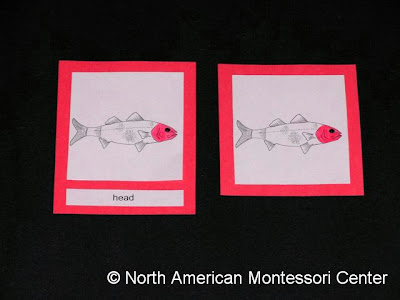Montessori Nomenclature cards (from the Latin nomenclatura – "assigning of names") are often used for building vocabulary and concepts in all subject areas. Also known as 3-part cards, this material is made up of pictures and labels. The simplicity of the material is in the picture of an object and its name. They can be used with non-readers as the Montessori children are able to match up the letters on the labels and figure out which label goes with which picture. Nomenclature cards use control cards as a built in control of error (Prepared Montessori Environment: Control of Error). This way, children are able to self-correct without interference from the Montessori teacher.
Learn how to create nomenclature cards as effective materials for your Montessori classroom.
Montessori Nomenclature Cards: How to Create and Use Nomenclature Materials
ArtworkTraditionally, hand drawn pictures were used to create nomenclature cards. However, with the wide availability, not to mention the lower cost of color printing, it is becoming more popular to use color photos. Lori, at Montessoriforeveryone.com, recommends keeping the simple line drawings for true nomenclature cards. "Drawings for nomenclature cards have traditionally been very simple, and contain only the "parts" that will be named and defined. It's very easy to isolate the salient part of the drawing, and kids will be very clear as to which name/label refers to which part." She believes that by using color photographs, there are new points of interest (colors, backgrounds) that draw attention away from the original intent and hinder mastery of the naming concept. Lori mentions that once children have mastered naming the parts of something (parts of the flower, for example), photographs are a very useful resource, and may be used when discussing the types (such as the types of flowers: daisy, rose, chrysanthemum, petunia, etc.)
Later, as Montessori children begin to want to understand more than just the name of objects there are 'definition' cards. These cards are actually 4-part cards as they contain a picture, label, definition, and control of error. These can be somewhat tricky to make as the definition does not include the label term.
Form
When making nomenclature cards, you will want to make at least two (and sometimes three) sets of the same material. One set is your control set, with the picture and label attached together. The second is the working set. The picture and label are separated and the child matches them. The third set can be used to make a definition booklet. The booklet is used after the child has mastered the nomenclature cards and is the template for the child to make their own definition booklet which he would color and label before taking it home.
For younger Montessori students, some teachers prefer making rounded corners so students do not hurt themselves on sharp-edged laminate. To do this you may trim the corners with a corner cutter, available at your local craft store in the scrap book section.
Presentation
Nomenclature cards are used after the child has received a lesson on a particular concept. For example, after the First Great Lesson, a child might be interested in learning more about volcanoes. Available on the geography shelf, are nomenclature cards for the parts of a volcano. The Montessori teacher presents a lesson on using the nomenclature cards by first laying out the control cards and showing the student how to match the picture and label to the control. Later, a second presentation is given where the child is shown to first match the pictures and labels, checking their work with the control of error cards.
Nomenclature cards are just one of the materials that make a Montessori classroom different from a traditional classroom. Instead of relying on textbooks and copied worksheets, students use the nomenclature cards to actively engage in the material. They are a beautiful work that encourages learning of concepts rather than rushing through to 'finish' a worksheet. NAMC’s Preschool/Kindergarten and Lower Elementary diploma programs include nomenclature templates on our blackline masters CD. These may also be purchased separately.
As much as possible, NAMC’s web blog reflects the Montessori curriculum as provided in its teacher training programs. We realize and respect that Montessori schools are unique and may vary their schedules and offerings in accordance with the needs of their individual communities. We hope that our readers will find our articles useful and inspiring as a contribution to the global Montessori community.
© North American Montessori Center - originally posted in its entirety at Montessori Teacher Training on Monday, May 26, 2008.
© North American Montessori Center - originally posted in its entirety at Montessori Teacher Training on Monday, May 26, 2008.




I have a question: Should Upper Elementary students be copying the definition when making their booklets or researching and writing their own definition?
ReplyDeleteThat is a very good question. I think it would depend on the level and ability of thestudent. Some students still struggle with copying definitions. Others are able to paraphrase. And some students are able to do their own research and generate their own definitions.
ReplyDeleteExcited to have discovered your blog. I am a homeschooler looking into nomenclature cards and was curious until what age they were typically used. I had not yet seen a version with definition.
ReplyDeleteWhat should be the standard size of nomenclature card?
ReplyDelete